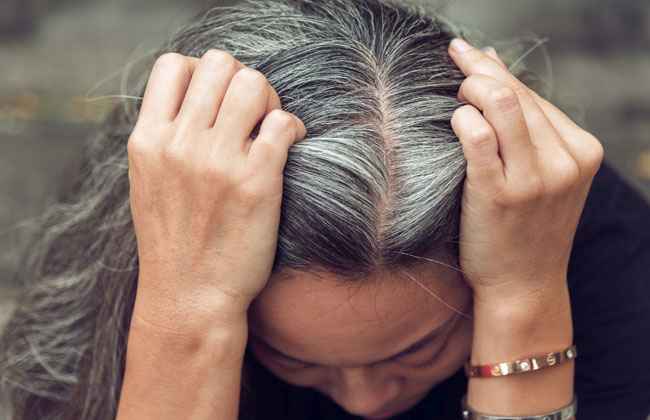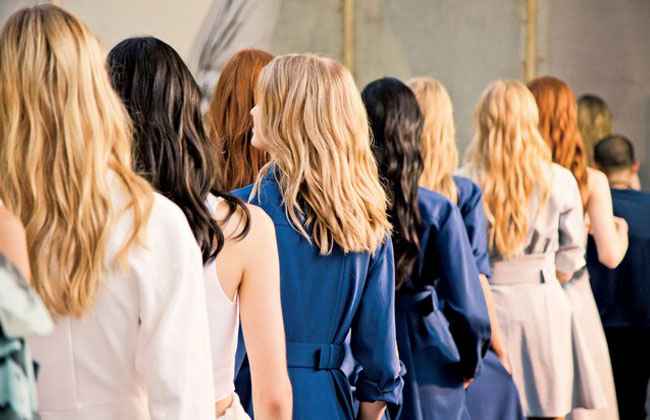9 Fascinating Things You Didn’t Know About Gray Hair
Most people tend to believe that their hair has started to turn grey, while modern science reveals that there is no such thing as turning grey-but in fact, the hair tends to grow gray from the follicles that emerge from the scalp.
While most women dread the arrival of gray strands and try their best to coat them with dark layers of colour and shiny pigments, many others adore the charming beauty of a silvery gray mane. If you are one of those women who hate the emergence of grey hair, there are various facts that you need to understand about the emergence of grey hair and how you can prevent its premature occurrence.
Dermatologists have conducted extensive research to point out factors and habits that prevent greying, along with highlighting some important factors that we didn’t know about.

Image: HealthyVogue
Let’s take a look at these 9 essential truths that we simply didn’t know about our greying strands:
1. The normal process of aging is the most notorious cause of greying hair
It should come as no big surprise that the natural process of aging tends to cause our hair to turn naturally gray. Dermatologists have termed as the 50-50-50 rule, and it basically outlines that 50% of the population tends to have a head full of 50% gray strands by the time they reach the age of 50.
Much like the skin, our hair tends to grow grey with age, and it also undergoes a series of changes in its texture, health, longevity and other factors.
2. Ethnic differences tend to influence the process of greying
Research reveals that the hair greying process tends to vary across different ethnicities. For instance, redheads are at the greatest risk of suffering from premature greying, while Caucasians also tend to grow gray strands sooner than Asians.
African-Americans are the least likely to experience premature greying. However, experts have yet to reveal why these differences occur across different ethnicities.
3. Stress has a MAJOR role to play in premature greying
It is interesting to note that even though stress doesn’t directly cause the hair to start turning gray, but in fact, it emerges as a risk factor that is prevalent across various hair and skin problems.
For instance, if you’re suffering from a chronic ailment, you are more likely to shed hair at an alarming speed. And stressful circumstances or even stress-inducing treatments, such as chemotherapy, can also cause the hair to grow gray strands rather than coloured ones.
4. Our lifestyle and habits influence the process of hair turning gray
Our lifestyle, eating patterns and other habits make a huge difference in determining how quickly the hair will start to turn gray. For instance, a habit like smoking can trigger the production of stressors within the hair and skin, leading to premature greying. Depleted levels of vitamin B12 within the body are also a notorious reason for the excessive loss of hair pigment and greying strands.
Dermatology experts strongly recommend the consumption of foods that are loaded with essential nutrients, vitamins, minerals and antioxidants, for instance berries, carrots and liver, to shield the hair cells against harmful toxins, along with preventing heart diseases, cancer, diabetes and even gray hair.
5. There is a vivid difference between your hair strands and their colour
Hair is generated from hair stem cells, and the pigment that colours our hair is made from an entirely different process, and with the help of the pigment producing stem cells. The hair dyes that we apply just give our strands a coat of colour, and they do absolutely nothing to change their structure or natural pigmentation.
Usually, the hair stem cells and pigment producing stem cells tend to work together, however, sometimes either of these stem cells can stop performing their function due to premature damage. Scientists and dermatology experts are attempting to develop a medicine or a formula that could be applied to the scalp in order to reduce the speed of the process of our hair turning gray.
6. Gray hair is basically the result of your hair getting naturally bleached
The hair turns gray by bleaching itself gray or white in colour, and this process is much similar to the process of getting a blonde dye with the help of hydrogen peroxide.
A recently published research attempted to shed light on this subject, and it explained that basically, hydrogen peroxide naturally emerges within the hair follicles, and as we continue to age, the concentration of hydrogen peroxide continues to increase. When hydrogen peroxide gets build-up in our hair follicles in large amounts, it prevents the development of melanin, which is basically the pigment that gives our strands their colour.
7. The hair never ‘turns’ gray, but in fact, it grows gray
We all believe that our coloured strands have started to turn gray while the truth is that as we continue to age, our new hairs have a greater likelihood of growing out gray or white in colour. You see, a single strand of hair takes around one to three years to grow, and when this strand is shed off from the scalp, a new strand emerges in its place.
So basically, the process of hair regeneration causes the pigment-producing cells to reform, and this causes the hair to wear out and shed.
8. Gray hair is much finer than coloured strands
Even though the popular belief is that as our hair start to turn gray, the strands tend to become rough, coarse and lifeless. Truth be told, gray strands tend to be much more fine and richer than the coloured hair, and despite being seemingly dry, the hair will be healthy. You see, the scalp only tends to be dry because as we continue to age, our scalp generates less and less oil.
This is primarily why gray hair seem to be rough, along with the fact that many people try to pull out their first few strands of gray hair, which also causes the hair to feel rougher and excessively coarse.
If you’ve developed a habit of constantly pulling out gray strands, keep in mind that this habit will make your hair crinkly and rough by destroying your hair follicles.
9. Gray hair naturally tend to be colour-resistant
If you’re tired of colouring your hair month after month only to be frustrated by the speedy re-emergence of grey strands, keep in mind that gray hair have a tendency to be much more colour resistant, which tends to be a surprise when you’re hair has just started to turn gray.
Certain gray strands that simply won’t take colour can be resistant towards hair colour. But you can easily combat this problem by picking out a darker colour for your roots, or even increasing your colour levels so you can provide the gray strands darker coverage.












Hi ?I have Grey hair… My first one started when I was 17 years old just behind.. More and more I have long grey hair.. Everybody always thought it was nice and said you have beautiful hairs! Photogrzphers asked to me to do picture and I did it. I’m 60 years old now and I stay on that way. I don’t want to do coloration (it’s not good and also you look older because also you can see it’s not tatural. So…
Thanks for all you share, it’s very interresting.
Regards